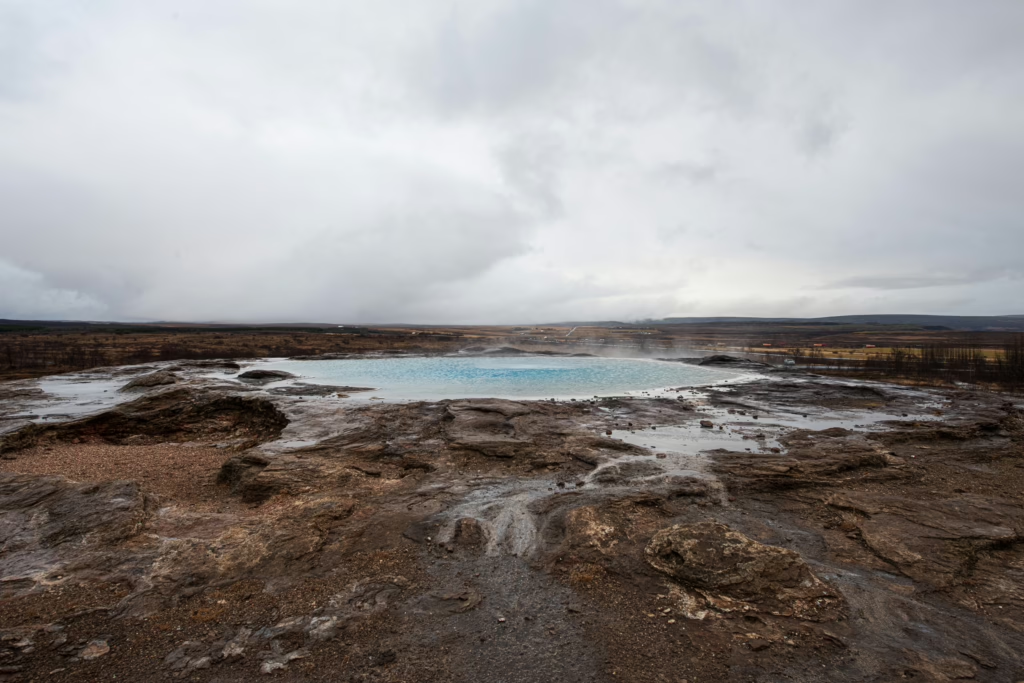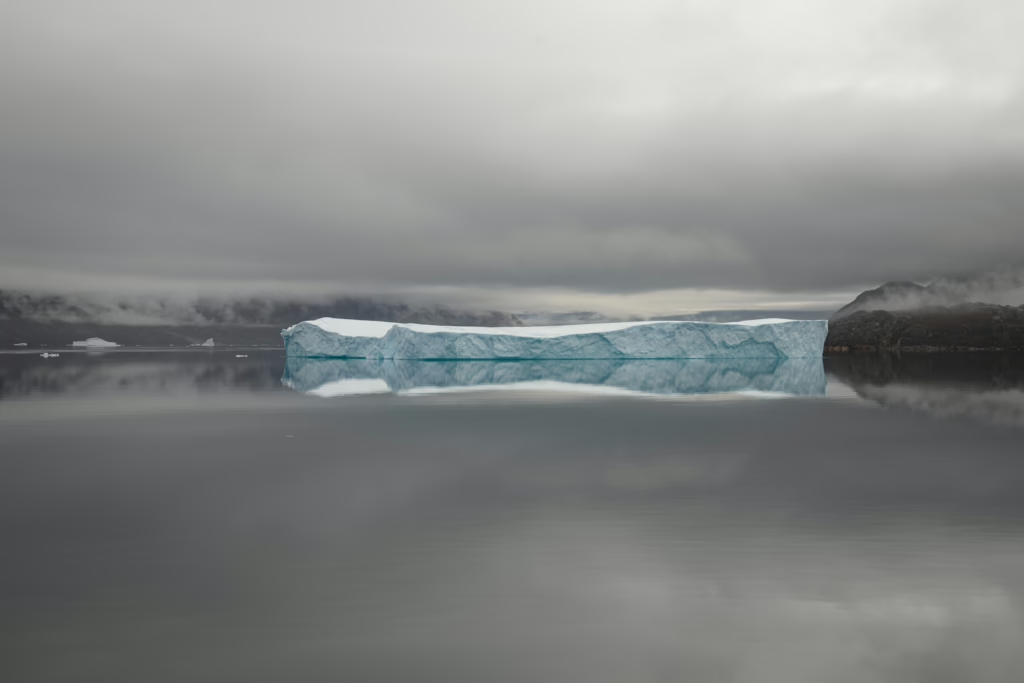People have strong opinions. But at the end of the day, if you enjoy the image, put it on your wall and enjoy it.
Most people will object to falseness presented as reality, and a fake image winning a competition. Let’s look at a few examples.
My Limits, Part 1, Intro
Let’s start with the things I do not care about.
#1 – Cleaning up sensor spots
#2 – Cropping / straightening
#3 – Black and White conversions
#4 – White balance correction / adjustments
I don’t think these are very controversial.
I also don’t even have an issue with selective desaturation. What do I mean? Sometimes objects in a scene have a strong color cast. Sure, this can be situational, but if you are inside of a glacier or other ice formation, there will be a strong blue cast. Sometimes, you can adjust for this by simply desaturating the image and it removes the blue color and turns it back to a near-black color.
Which one of these photos do you like more?


The day we were at Geysir in Iceland was not the most scenic. Since we were there in November, it was also really dirt-colored. This image would probably have been thrown away, but by desaturating the dirt, increasing the contrast and darkening the sky, and then keeping the hint of blue in the thermal pool, it turns it into something nice.
But what do some other photographers think and do?
No Names, but if you Know me You Know Who This Is
Someone I know is very strict with how much editing he will use, and in general, he tries to use the entire frame when capturing a scene. He will attempt to make the resulting image as true to the feeling as possible. With that said, as true to the feeling of being there does mean you make some changes. For some of his work, if we look at photographing penguins in a snowstorm in Antarctica, there may be a bit of effort to get the colors back.
But he will never take >1 shots and try to present it as reality.
And Another California Photographer
In the past, I attended several of his workshops. And while I haven’t spoken to him in a while, I do remember some of his thoughts.
The biggest reason he will go out of his way to avoid even focus stacking is that he doesn’t enjoy all of the editing.
Well Known Photographer
This person became famous due to his photography that blends different times of day with each other. I’ve heard this described as photo-based art more than just photography.
My Limits, Part 2
There is a lot of different thoughts on what is the ‘limit’ of editing.
Maybe you want to set the limit to ‘if you could do this with 1 frame of film, it is ok’. Oh boy, you’d be so surprised what was capable with ‘just film’. Even in the 1920’s, movies were able to perform in-camera compositing by using black cloth over part of the frame, rewinding and shooting something else over a different part of the frame. And then there was Ansel Adams. He pioneered many techniques used in darkrooms and even Photoshop today. Do you know the ‘dodge’ icon in Photoshop? That mimics and old darkroom tool to selectively underexpose a small portion of the frame, which would make it lighter (at least in negative film process, unsure if going positive to positive). Photoshop masks? These used to be black cardboard that you could cut out and expose different sections of the print with different settings. Even contrast was adjustable – in black and white film to b/w print, using a red filter on the enlarger would increase contrast and yellow would decrease it. The limits of a darkroom and the limits of Photoshop up through about 2010 were not that far apart. Photoshop was, of course, easier, repeatable, and didn’t expose you to crazy chemicals, but the end results were not that dissimilar.
When I was still printing from film, around 2006 or so, the process was already computerized where a machine operator would look at the image, make the changes they wanted, and the computer would optically transfer, with changes, to the print.
All photos require something. I’d argue that even film requires some edits to be the best. Sure, a snapshot is probably just as good right out of camera as with an hour of work, but an epic landscape, generally not so much. If you shoot RAW, the file that is presented is a bit bland and lacks contrast. But this is by design. Let’s look at the example below — the top is the edited version and bottom is the just opened RAW.


I adjusted some of the bright and dark areas to give the image a nice curve. I also pumped up some of the contrast and blues on the iceberg itself, while desaturating the background around the iceberg. The changes were subtle but it really brings the focus to the strong blues. It also got a bunch of people to stop by my booth, but no one decided to purchase this image. I made a print that was 12x18in and it is quite the eye catcher. No clue if a normal person would want it on their walls, but if it gets you to stop by and buy something in my store, it has done its job.
Where is the Line?
It might be cliche to say ‘this is different for everyone’. For me, I won’t add anything (like dropping a moon in where there wasn’t one) nor will I add something like a tree, bush, fence, etc. But I will remove some of these items if it helps to clean up distractions. I will definitely remove trash if it shows up, although I may have moved it before I even took the image. I also have no issues with cropping to adjust elements or to fit my desired aspect ratio.
Everyone has a personal spot for ‘this is too far’. I certainly have taken images too far in the past. If I shared these images, it was a long time ago and I made it obvious that there were heavy edits (a lot of us went through a HDR phase, it was a lot of fun, and we all left it in the past). Or I decided to just keep them private. Once you go to a certain point – especially once you are an authority or professional – it is hard to say ‘oh yeah for this image I took slices from 25 images, ran it through all of this software, but this other one, that’s basically straight out of camera’.
Now with all of my talk about the purity of photography, I also have to mention astrophotography. I like it, it is fun. But many of the images you see are 2-10 hour exposures or stacks of images taken over 2-10 hours. These images could barely exist without modern cameras and software (film has something called reciprocity failure and in short after some time, doubling the exposure time does not double the light captured. Digital sensors will get hot over time and can cause pixels to go hot). And yet they are amazing when done well.
I am not a documentary style photographer. I do not have anything against using multiple frames to composite into a final image, but I will say when this is done. My iceberg image above was one that most people didn’t think was real – yet as someone who was there, it captures the feeling of being there, and I would say that it was what it was like. Sometimes in some situations the colors the camera thinks are right are not right. I’ve mentioned this before on some aurora posts. And in this case, the icebergs really are this vibrant blue that is very hard to describe. I should do a post on this.
Conclusion?
Editing is not bad, has been around since the beginning of photography, and is both necessary and can improve your images. The ‘rules’ are different depending on your end goal – something that is documentary or for the news naturally requires the minimum editing. But I will mention that even the famous ‘tank man’ image is a heavy crop to achieve the result. Editing to create an art for wall hanging really has no hard limit, just how much the photographer wants to do. And I think that is nice.
Until next time.
-Brad